The Samsung Galaxy S9 and S9+ Review: Exynos and Snapdragon at 960fps
by Andrei Frumusanu on March 26, 2018 10:00 AM EST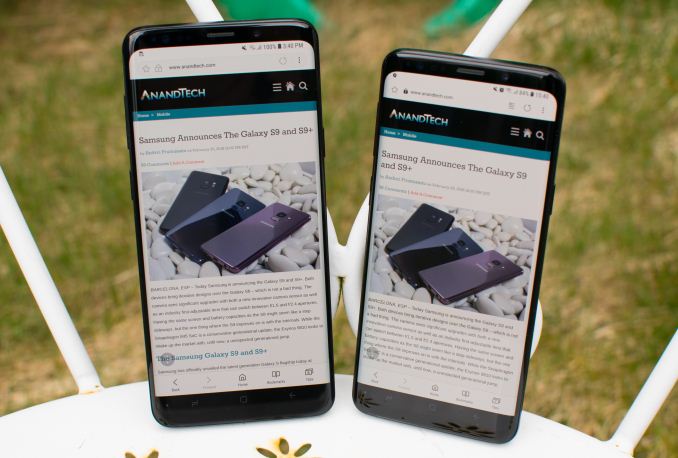
Samsung’s Galaxy S series over the years are the devices that most people associate with flagship Android experience. The company has been a constant in the mobile landscape while we’ve seen other players, either successfully or unsuccessfully, attempt to dethrone the Korean chaebol’s position in the market. Being at the top also means that there’s a lot to lose, so risk aversion is encoded into the Galaxy S’s series’ DNA over the generations. For Samsung to execute well, it needed to devise a plan to make the S9 attractive to consumers. This comes at a time where Apple sees a great reinvigoration of success through the new iPhone X which drastically changes the competitive landscape, so playing it safe might not be the best route for success for Samsung every single time.
In this review we’ll be posting extensive coverage of the two biggest stories surrounding the Galaxy S9: its camera and its new SoCs. We’ll dwell deep into the picture quality of the new unit and do a wide comparison against today’s most popular flagships. The central processors, the Snapdragon 845 for the US/China/Japan, and the Exynos 9810 for most of the rest of the world, are at the heart of the phone and a key element to how the device feels and performs. We’ll be having an extensive in-depth look into their performances and attempt to explain how they tick.
The Galaxy S9 is a device which fully embraces the saying of “If it ain’t broke, don’t fix it”. This year’s Galaxy S is a generation of refinement rather than one of big changes, and to see the differences between the Galaxy S8 and Galaxy S9, we have to look into the details.
| Samsung Galaxy S9 Series | ||
| Samsung Galaxy S9 | Samsung Galaxy S9+ | |
| SoC | Qualcomm Snapdragon 845 (North & Latin Americas, China, Japan) 4x Kryo 385 Performance @ 2.8GHz 4x Kryo 385 Efficiency @ 1.77GHz Adreno 630 @ 710MHz Samsung Exynos 9810 (Europe & Rest of World) 4x Exynos M3 @ 1c 2.704GHz, 2c 2.314GHz, 3-4c 1.794GHz 4x Cortex-A55 @ 1.79GHz ARM Mali-G72MP18 @ 572MHz |
|
| Display | 5.8-inch 2960x1440 (18.5:9) SAMOLED (curved edges) |
6.2-inch 2960x1440 (18.5:9) SAMOLED (curved edges) |
| Dimensions | 147.3 x 68.5 x 8.3 mm 164 grams |
157.5 x 73.6 x 8.2 mm 189 grams |
| RAM | 4GB LPDDR4-1866 | 6GB LPDDR4-1866 |
| NAND | 64GB (US maximum), 128GB, 256GB (UFS 2.1) + microSD |
|
| Battery | 3000 mAh (11.55Wh) non-replaceable |
3500 mAh (13.47Wh) non-replaceable |
| Front Camera | 8MP, f/1.7, Contrast AF | |
| Primary Rear Camera | 12MP, 1.4µm pixels, dual-pixel PDAF, Tri-stack CMOS Sensor (Embedded DRAM), 4K60, 1080p240, 720p960 high-speed recording Adjustable aperture f/1.5 or f/2.4, OIS, auto HDR, LED flash |
|
| Secondary Rear Camera | - | Telephoto lens 2x zoom 12MP, f/2.4, OIS |
| Modem | Snapdragon X20 LTE (Snapdragon Integrated) 2G / 3G / 4G LTE (Category 18/13) DL 1200 Mbps (5x20MHz CA, 256-QAM), UL 150 Mbps (2x20MHz CA, 64-QAM) Shannon 360 LTE (Exynos Integrated) 2G / 3G / 4G LTE (Category 18/13) DL 1200 Mbps (6x20MHz CA, 256-QAM), UL 200 Mbps (2x20MHz CA, 256-QAM) |
|
| SIM Size | NanoSIM | |
| Wireless | 802.11a/b/g/n/ac 2x2 MU-MIMO, BT 5.0 LE, NFC, GPS/Glonass/Galileo/BDS |
|
| Connectivity | USB Type-C, 3.5mm headset | |
| Features | Fingerprint sensor, heart-rate sensor, iris scanner, face unlock, fast charging (Qualcomm QC 2.0, Adaptive Fast Charging, USB-PD), wireless charging (WPC & PMA), IP68 water resistance |
|
| Launch OS | Android 8.0 with TouchWiz |
|
Starting off with a quick talk about the hardware specifications, we see Samsung’s mobile division continue the trend of dual-sourcing SoCs. American, Chinese and Japanese markets will receive Qualcomm Snapdragon 845 powered phones, while European and other markets will receive Samsung LSI’s Exynos 9810 silicon. For what our testing in this review will show, this year will see huge differences between the two SoC variants so we’ll focus in-depth on the details and effect this has on the overall product experience between the two versions over the next several pages of the review.
S9 and S9+: Major Differences and Design
The Galaxy S9 continues the trend of coming in a “regular” form-factor, joined by its larger sibling. dubbed the Galaxy S9+. Ever since the introduction of wider aspect ratio screens by various vendors last year, it’s become quite unintuitive to talk about smartphone sizes in terms of screen diagonal. The Galaxy S9 comes with a 5.8” screen, however much like the Galaxy S8 last year it fits a “regular” footprint with a 68.5mm body width.
The Galaxy S9+ with its 6.2” screen fits within a 73.6mm body width, remaining more compact than other large variants of phones such as the iPhone 6/7/8 Plus, LG V30, the Pixel 2 XL, or others.
Both the Galaxy S9 and S9+ shaved off respectively 1.5 and 2mm off the vertical height, however this reduction in footprint came through flattening of the rounder frame of the Galaxy S8 rather than a reduction of the front faces of the phones.
The larger Galaxy S9+ houses a 16% bigger battery, coming in at 3500mAh/13.47Wh advertised capacity, versus 3000mAh/11.55Wh for the Galaxy S9. This year in particular we’re seeing a greater number of differences between the regular S9 and S9+ as Samsung opted to give the bigger variant a fixed 6GB RAM configuration, while the regular variant remains at 4GB like last year’s Galaxy S8’s. I haven’t seen an immediate need for the larger RAM configuration, as in my short time with that model I saw well over constant 2.5GB of unused memory in every-day usage.
The biggest feature discrepancy between the Galaxy S9 and S9+ however is the addition of a telephoto lens on the S9+. As I talked about this in our announcement article, I’m not a big fan of this feature disparity between size variants as it was first introduced by Apple in the iPhone 7 Plus – personally I vastly prefer the smaller form-factor but I feel left out not having the option of the second camera.
The new main camera on the rear has seen immense upgrades both on the sensor side as well as the optics of the module. The new sensor includes a new tri-stack design including the CMOS array, the integrated ISP, as well as now a dedicated DRAM die, all integrated with each other on the same silicon package thanks to the use of through-silicon vias (TSVs). This new design allows – among other things – 960fps video capture, as well as fast sequential image capture. The sensor is still a 12MP piece and employs 1.4µm pixels for low-light sensitivity.
The optics of the new module includes a dual-aperture system that is able to switch between the native F/1.5 aperture of the lens assembly and a reduced aperture of F/2.4 for brighter situations. The new lens system promises the benefits of great low-light photography while avoiding the issues of the shallower depth of field of the native optics system when switching to F/2.4.
With Samsung’s marketing making a great deal of noise around the new camera, we’ll be focusing ourselves in-depth onto the subject and shed some light on the matter with an extensive exposure across a dozen recent flagship devices later in the review.
Still on the back of the phone we see more changes to the layout around the camera. First off the fingerprint sensor is no longer alongside the camera – where we now once again find the flash and biometric sensors – but rather is underneath the cameras. Instead of two cut-outs like on the S8, the S9 only comes with a single large one that houses both the cameras and the fingerprint sensor; this is the most distinct change in feel between the S8 and S9 as the edge of the metal edge of the camera/fingerprint housing is sharper than the more smooth back of the S8. Personally I liked the side positioning of the S8 a lot more, as on the regular S9 the fingerprint sensor feels too low now compared to where you rest your thumb on the power button. On the S9+ I might see benefit of the new positioning, but again this is something subjective to most people.
The LED flash for the first time for Samsung now actually includes a circular light diffuser. It took Samsung 9 years to integrate one but finally here we are and the result is a smoother and less square illumination while only losing 5% in measured brightness.
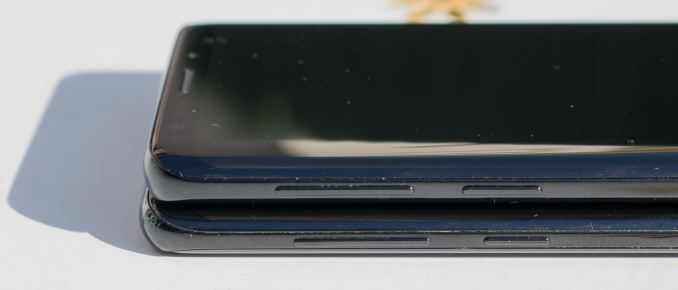
Galaxy S9 (top) & Galaxy S8 (bottom)
Among other minute design changes of the Galaxy S9 versus last year’s S8 are the button designs and placements. The S9’s buttons are seemingly more tapered off and thus feel wider and less sharp than the S8’s. They also feel to be clickier and have more travel distance to them than on the S8, something that’s especially felt on the power button. The power button as well as the Bixby button have gained 3mm in length, making them easier to press. Samsung has also moved all buttons upwards by a couple millimetres, something that I hadn’t noticed at all at MWC or in my first days with the device. I can’t tell if the new position is beneficial or not, but looking at it again it does look like my thumb rests more centred on the power button than on the S8, which might be one of the reasons in the ergonomics change.
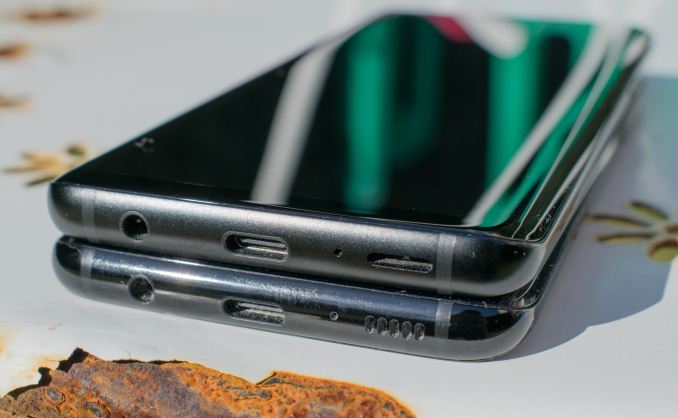
Galaxy S9 (top) & Galaxy S8 (bottom)
Another large functional change that isn’t directly visible but definitely audible is the new speaker system. Externally the only thing that has changed from the S8 is the speaker no longer has a speaker grill in front of it but rather a continuous open slot onto a slanted membrane that protects the speaker chamber from water and dust intrusion. The S9 and S9+ now also feature stereo speaker functionality as the upgraded 2mm wider earpiece grill will now also output media audio alongside the main bottom speaker.


Basic peak spectrum through main speakers - Galaxy S8 (top) vs Galaxy S9 (bottom)
I did a quick audio spectrum measurement of the S9’s output and you can see that the peak output at higher frequencies is 6 to 12dB higher than on the S8, while simultaniously losing some 10dB in the lower mid-ranges. In practice the S9 doesn’t seem to sound much louder, however the sound is immediately noticeable as a lot fuller and wider range than most other smartphones, including the latest iPhones and the Pixel 2’s.

Galaxy S9 (front) & Galaxy S8 (back)
Finally the last externally visible difference between the S8 and S9 is that now the iris sensor on top of the phone is now hidden and no longer requires a transparent cut-out in the front glass. If the bottom speaker slot doesn’t expose the phone as an S9 then the inclusion of only one instead of two visible sensors at the top will discern it from a regular S8.
In terms of design, Samsung clearly focused on iterating and perfecting on the S8. The S9 keeps an extremely attractive design. The most notable in-hand feel change is the flattening of the side frames and the rear fingerprint assembly. Personally again, I’m still not too sure which one I prefer. There may be other practical considerations for the S9’s industrial design changes such as improved durability when dropping the phone on its sides. Overall I still think overall that the S9 is one of the most ergonomic and comfortable phones to hold – something Samsung’s designers will have a very tough time with iterating in the future, for better or worse.
The Samsung Galaxy S series have been over the years the flagship devices that lead the introduction of new SoCs. This generation the Galaxy S9 and S9+ come as among the first commercial devices with Qualcomm’s Snapdragon 845 and S.LSI’s Exynos 9810. Part of the focus point of this article is a deep look into the characteristics of both these SoCs and see if Qualcomm’s and Samsung LSI’s projections in performance and power bear fruit.


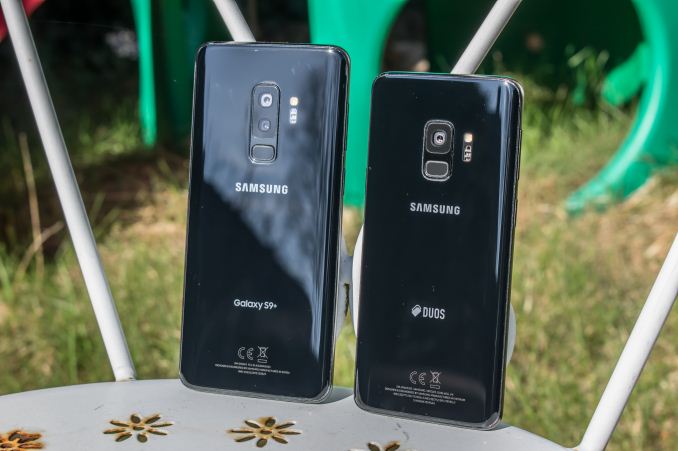
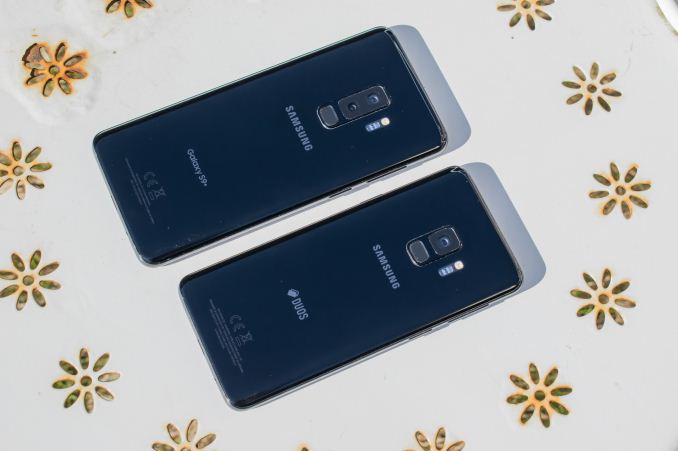
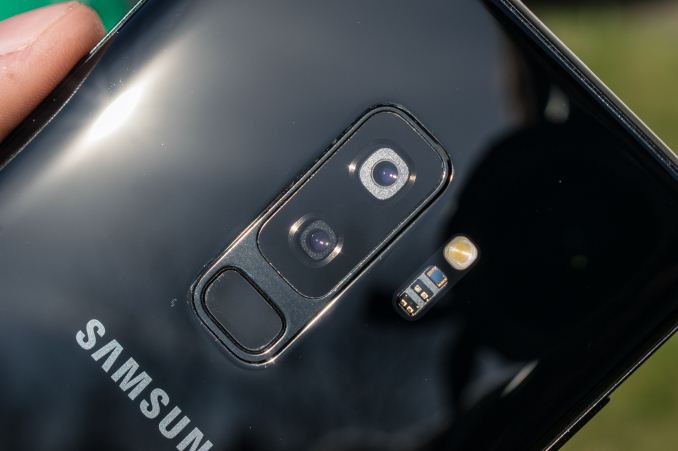








190 Comments
View All Comments
peevee - Friday, April 6, 2018 - link
Essential 2?Given small real-life difference between 845 and 835, Essential PH-1 is still a great device. And very appropriately priced. Nothing to wait there.
StrangerGuy - Tuesday, March 27, 2018 - link
All the S9 did was made me appreciate my S8+ more, of which I only bought because of generous employer benefits. Without which I wouldn't even have cared about these overpriced flagships.Valantar - Tuesday, March 27, 2018 - link
I pointed this out in your S9 launch article, and apparently I have to make my point again: neither light nor depth of field is the reason for the aperture change - it's purely to combat distortions and lack of sharpness in the image due to the combination of a large aperture and tiny, tiny glass.Why? When it comes to depth of field, one needs to factor in not only the aperture, but also the crop factor (sensor size relative to standard 35mm film). As such, f/1.5 on a standard cell phone 1/2.3" sensor is roughly equal to f/8.4 on a 35mm sensor, or f/5.6 on an APS-C sensor. This is one of the main photographic advantages of large-sensor cameras: that you can get shallow depth of field with lenses that are actually possible to manufacture.
An example: https://dofsimulator.net/en/?x=EAyAeuF3AAAIJEwkAAA...
As you can see here, with a 1/2.3" f/1.5 sensor, focusing on a subject 3m away gives you an in-focus area of ~43m - this is NOT too little, not by any measure. Moving the subject to 5m gives you effectively infinite focus, with everything from 1.9 to infinity being in the focal plane. You'd need your subject at less than .5 meters for DoF to be an issue - which it would be with most cameras at that distance.
On the other hand, it's well known that for large apertures, anything but the best glass will lead to aberrations and distortions in the image, and a general loss of sharpness across the frame. Look at even a single DSLR lens review - they're _always_ sharper when stopped down. With a lens stack this tiny, there's no feasible way to control this - it's likely physically impossible to avoid aberrations and distortions at an aperture number like this. Hence, the variable aperture.
Now, AT is usually very accurate in their reporting. Could you PLEASE correct this? Pretty please? Since you claim to be doing a deep-dive into the camera, this is not a good look.
Valantar - Tuesday, March 27, 2018 - link
To clarify: You say that "The F/2.4 aperture in day-light shots is not a gimmick and very much an advantage to the S9 as its deeper depth of field is noticeable in shots, producing sharper images than the F/1.5 aperture." This is a misunderstood conclusion. The added sharpness is largely not due to a deeper depth of field, but rather due to the stopped-down aperture resulting in a generally sharper image. This conflates two different characteristics, focus depth and lens/optical sharpness. These are not the same. If you did a more rigorous test where both cameras focused on the same spot (ideally not in the centre of the image) in a scene with sufficient depth, or conversely shot against a flat target with a lot of detail, you'd likely see this pretty clearly, as _even the focal point_ would be sharper at f/2.4. If this was due to depth of field, both settings would be equally sharp at the focus point, while what you're saying here is that f/2.4 is sharper _across the image_. That's a typical effect of a smaller aperture improving sharpness, not of the smaller aperture restricting DoF.peevee - Friday, April 6, 2018 - link
" _even the focal point_ would be sharper at f/2.4"If it is the center, it might not be so because with such tiny sensor, at f/2.4 maximum resolution is diffraction-limited. Need the exact size of the sensor to confirm, but I am almost sure than even at f/1.5 Airy disk is bigger than a pixel.
Takethis - Tuesday, March 27, 2018 - link
Any chance they Samsung could fix their “slow-and-steady” DVFS approach with software updates? Given the actual state of things, Snapdragon 845 phones are the one to buy this year (I'm thinking Oneplus 6)Ankurg - Tuesday, March 27, 2018 - link
With due respect to the author and the site, I have to believe that most of the extensive tests and their results will not affect the avg day-to-day usage of this device.I am already seeing the panic this review has created on reddit, with many people now re-thinking whether to purchase or not...
Yes, most youtube/site reviewers don't go as deep as this, but a problem so steep would have been felt.
I would advice my fellow mates here not to lose sight of the fact that this is the best android phone you can buy right now.....irrespective of the choice of chip.
SirCanealot - Tuesday, March 27, 2018 - link
"With due respect to the author and the site, I have to believe that most of the extensive tests and their results will not affect the avg day-to-day usage of this device."While I'm happy to have a super-fast phone with crappy battery life, I'm not happy to have an average-speed phone with crappy battery life. IE, I have a Exynos Note 4 which is fast with crappy battery life and it still does the job...
The crappy battery life is going to effect every single user and every one of your friends in America is going to get a better performing phone with better battery life. Day-to-day I'm getting worse performance and battery life; this means I can re-consider my options now I have all the data.
Why shouldn't this review make you reconsider? That's what it's meant to do. Unless you're a Samsung shareholder, I wouldn't pay any attention to this completely normal thing of human society...
id4andrei - Tuesday, March 27, 2018 - link
The author himself stated that you will not see any difference as an ordinary consumer. Some slight circumstantial scrolling stutters are all he noticed.Still the Exynos underperforms relative to its advances in chip design.
peevee - Friday, April 6, 2018 - link
"The author himself stated that you will not see any difference as an ordinary consumer."Nope. The fast core only winding up after 0.4s is VERY noticeable as good phones will already finish launching an app or rendering a local HTML in Webview by this time, some time ago.